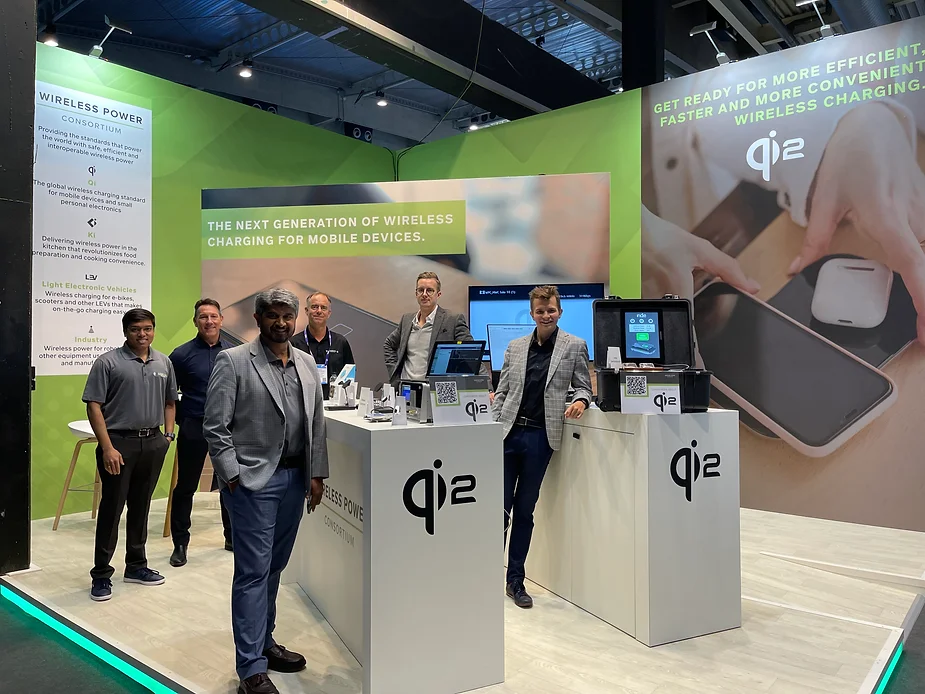Convenient and Efficient On-the-Go Wireless Power Delivery with Qi2
by Paul Hollingworth, EVP of Sales and Marketing
While not yet ubiquitous, wireless charging has become widely available for smartphone users, with many of today’s phones supporting cord-free power transfer. This allows consumers to power their phones from standalone charge units and charging pads integrated into work surfaces, furniture and, more recently, vehicles.
Charging a phone on-the-move is a high priority for car buyers who, increasingly, rely on their device to provide navigation, music, voice connections, and other services as they travel. In addition to USB-based wired power delivery, wireless charging is rapidly being adopted as manufacturers look to create in-cabin experiences that match the needs of their tech-savvy, gadget-dependent customers. As a result, the global automotive wireless charger market, which was estimated at U.S. $ 1.3 billion in 2022, is expected to surge ahead at an impressive CAGR of 21.9% until 20321.
Charging Solutions
Most in-cabin charging uses Qi (pronounced “chee”), an open interface standard developed by the Wireless Power Consortium (WPC) that defines wireless power transfer with inductive charging. Qi enables compact and cost-effective solutions that ensure full interoperability between the vehicle’s wireless charging base station and the mobile phone.
Recently, the WPC unveiled Qi2, a significant upgrade to the standard that improves both efficiency and ease of charging. A key element of this standard is a magnetic power profile (MPP) that uses magnets to position the smartphone. MPP offers faster, user-friendly charging by automatically aligning the smartphone with the inductive charging coils to achieve maximum power transfer efficiency. And, in the case of in-cabin applications, the magnets also ensure the phone stays in position irrespective of a vehicle’s movements or the bumpiness of the ride. As an additional benefit, the Qi2 standard will significantly reduce the wear on the battery, charging a mobile device during a commute and enabling operation above 50% state of charge.
Improving in-cabin user experience is a core focus for indie (see our previous Blog) and the company is developing Qi-based wireless charging semiconductors that bring together, in a single chip, previously discrete, external components and sub-systems. This high level of integration allows automotive OEMs to simplify system design, reduce component count, form factor and cost, and minimize development and prototyping time.
Take, for example, the recently launched iND87200 IC. Automotive-qualified to AEC-Q100 Grade 2, the iND87200 is fully compliant with the WPC 1.3 specification and offers support for Qi2 and MPP.

In addition to integrating the DC-DC inverter and power management blocks, the device incorporates advanced power-sensing circuitry that provides real-time monitoring of system impedance and phase. Unlike alternative solutions, this capability allows system designers to optimize tuning and charging algorithms to enable intelligent functionality such as foreign object detection. Integrated power management functionality supports connection directly to the automotive power bus, while a unique amplitude-shift keying (ASK) demodulation engine enables robust operation over different filtering and coil matching combinations.
The iND87200 dual-core design combines an Arm® Cortex® M4F processor with 2MB of embedded Flash and 256kB of SRAM together with a dedicated Arm® Cortex® M0 processor for the WPC stack. This frees the device to execute user-specific software without timing and interrupt constraints related to the WPC stack.
Demonstrating Wireless Charging at MWC2023
At the 2023 Mobile World Conference (MWC) in Barcelona, indie joined forces with the WPC who were demonstrating a variety of next-generation wireless charging solutions.
Visitors to the WPC booth got to experience a hands-on demonstration with indie’s custom center console display (figure 2) and test the wireless charging performance with a variety of phones. The demo, which featured the iND87200 IC within the charge pad, exhibited highly efficient power delivery for optimized and rapid charging and showcased the benefits of the magnetic alignment and tight inductive coupling that result from the chip’s support for MPP.

Paul Golden, Marketing Director for the Wireless Power Consortium, commented: “From navigation to entertainment, for a growing number of drivers smartphones are an essential addition to in-vehicle infotainment systems. The ability to conveniently charge these devices is a critical element of the journey and wireless systems that make charging simple and efficient are fundamental to enhancing the in-cabin experience. indie is helping automakers deliver these enhanced experiences by providing advanced SoC technologies that combine high-performance charging with simplified, efficient implementation.”

Summary
Drivers and passengers expect vehicles to provide safe, engaging, and productive journey experiences, including seamless interfacing and rapid charging of smartphones as they travel. Wireless charging based on the latest WPC Qi2 standard brings a new degree of freedom and convenience for vehicle occupants, and indie is excited to enable this with high performance, cost-effective silicon innovations such as the iND87200.
